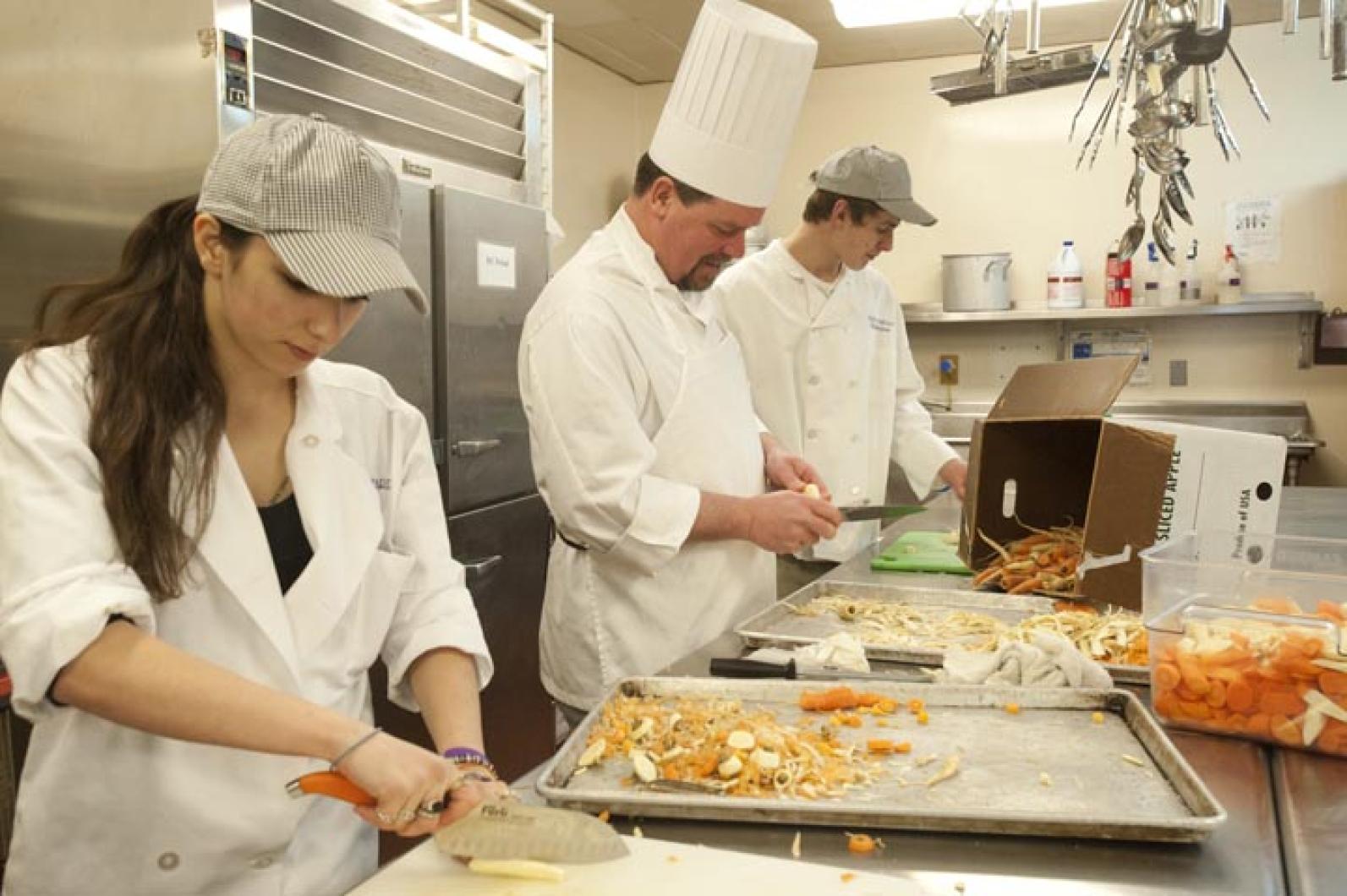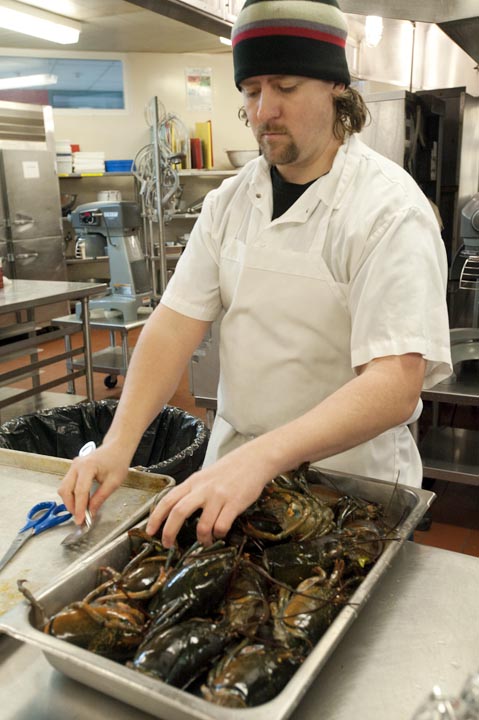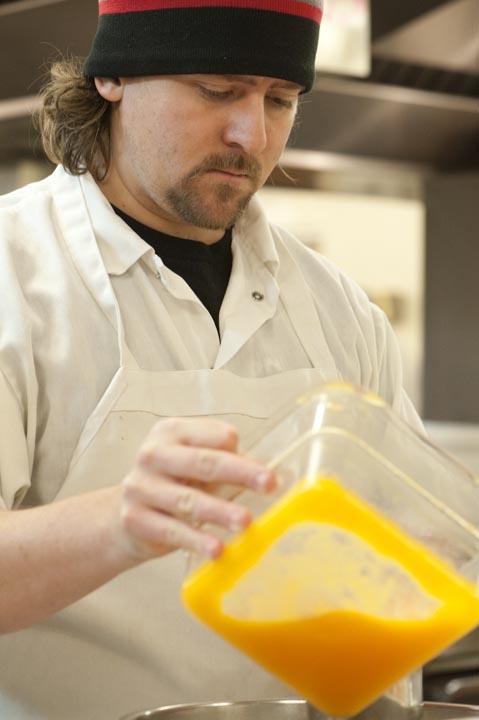What to have for lunch — grilled hamburgers or cafeteria food? It was an easy choice for the culinary arts students at the Martha’s Vineyard Regional High School on Tuesday late morning before they started prep work for a dinner function that night. Ethan Himmel flipped burgers in the kitchen while Carlos Guzman toasted bread in the convection oven and got out cheese.
“Do you want to roast that chicken off?” culinary arts teacher Jack O’Malley asked his students who were still deciding what to eat for lunch. Mr. O’Malley had planned to teach a dish of chicken with apples on Tuesday, but suddenly dinner preparations were a priority and the chicken would go to waste if it weren’t cooked.
Guest chef Daniel Sauer, owner of 7a Foods, an Aquinnah farm and catering company, arrived at about 11:30 a.m. with an armful of lobsters, ready to get down to business. An Italian family-style dinner was planned for that night sponsored by Island Grown Schools, as a benefit for the department’s Petricone Scholarship fund. Mr. Sauer and the culinary arts students worked together all day on the dinner.
Kelci Greer and Ryan Fisher were busy peeling carrots and turnips.
“I think I’m beating you,” Kelci said to Ryan as they painstakingly peeled root vegetables from Morning Glory Farm.
“I like having different chefs in here and having different personalities to work with the kids,” Mr. O’Malley said. “It’s good for them, I enjoy it. I’ve had a lot of kids get job offers in the past from the different chefs that have come through. They may see something in a particular kid, and offer them a job or remember them when they do come for an interview later on. It’s a win-win,” he said, adding:
“The more we can support the local farmers, the more I can expose the kids to local chefs — it’s great.”
Mr. O’Malley has led the culinary arts program for the past seven years, bringing in guest chefs often. He and his students have worked with Michael Brisson of l’étoile, Robert Lionette and Jan Buhrman of Kitchen Porch and Top Chef season one finalist Dave Martin.
And even when they’re not preparing for functions, Mr. O’Malley’s students are constantly cooking. He typically runs them through a skill packet that includes 12 recipes — three entrees, three starches, three soups and three desserts. His method of teaching has produced many Culinary Institute of America graduates; some have returned to the Island.
“It’s kind of neat, one of my student’s invited me to game night at David Ryan’s and while I was there, the chef came out of the kitchen,” Mr. O’Malley said. “It was Josh Merrill, one of my former students so that was pretty cool to see.”
Other successful culinary arts graduates include Steve Perry, who has worked at l’étoile, the Boathouse in Edgartown and the Outermost Inn in Aquinnah; Brittany Andelin, who worked at the Edgartown Yacht Club; and Ryan Gorman, who does catering in New York city.
Mr. O’Malley’s training also has a purpose.
“I do it so that next year I know we’re all on the same page,” Mr. O’Malley said. “I can say, remember how we made that chicken, or the pan sauce we made or how we braised that pork shank. They’ll all know what braising is and I can refer to it . . . . because it is a comprehensive high school and the classes are fluid, I can have kids come in to different classes. For my own benefit I do it that way so we can speak the same language.”
Freshmen and sophomore classes generally are more instructional, where students are able to work with recipes and get used to the flow of the kitchen. Juniors, seniors and some sophomores put their skills to use with customers, including at monthly senior lunches or backdoor bistro days, when they sell à la carte orders to faculty and staff.
What are favorite student dishes? Mr. O’Malley said freshmen like to deep-fry anything, and he said when students first learn how to master one dish it’s all they want to make. He said it calls to mind his own earliest experiences as a chef. “There are some things that I remember when I was younger, like when I first learned how to make pâtéà choux, oréclair paste,” Mr. O’Malley said. “When you add the eggs to the flour and put it in a hot oven how it just expands and it just comes out as a magical pastry.”
But peeling carrots and doing the dishes (the students rotate these chores) help to proof the true chefs.
“I’ve had a lot of kids come in and they know they want to be a chef and this is what they want to do with their life,” Mr. O’Malley said. “They might decide this isn’t for me. This program exposes them to what it’s like and gives them a little taste of reality before they commit. It’s just as valuable to learn that maybe this isn’t for you.”
He continued: “By the same token I have kids that do it and they have other plans in their lives, they go to college and they end up coming back to culinary even if it’s not what they planned.”
After finishing his hamburger, Carlos began slipping the skins off roasted beets. Kelci sharpened her knife to cut root vegetables on the bias. Mr. Sauer took apart the lobsters.
“You see how he’s doing that?” Mr. O’Malley told his students.
“You should use a peeler, not a paring knife,” he told another.
Later that night, the group was still cooking away as guests arrived in the culinary arts dining room. Family members, friends and farmers sat together at long tables as students served field greens with roasted beets, seafood risotto, meatballs with Farm Institute beef, Grey Barn veal and Allen Farm pork, potatoes alla Contadina, roasted root vegetables and a buttermilk panna cotta with clementine jelly. As diners ate family style, sharing large plates of the meatballs and reaching for more potatoes, students made sure everyone had what they needed. They were generous, attentive and hospitable.
“It was a good group of kids; it was fun,” Mr. Sauer said. “I want the kids to know that you can find local ingredients in winter, things that are not too expensive, and still make a great meal out of it. It doesn’t always have to be a pork tenderloin or perfect vegetables.”
Junior Maxwell Moreis helped Mr. Sauer plate the dinner between doing the dishes.
“It’s awesome to have local chefs come in and share their experience with us, and be able to work with local ingredients,” he said, drying a plate.
“At the end of the day, I want them to know that hard work is rewarded especially in hospitality,” Mr. O’Malley said. “There’s always room for advancement and if you do your job well, the sky’s the limit.”











Comments
Comment policy »